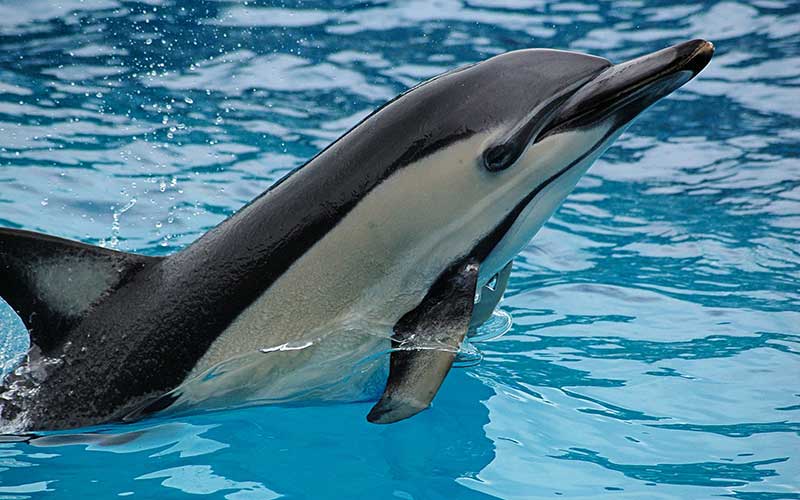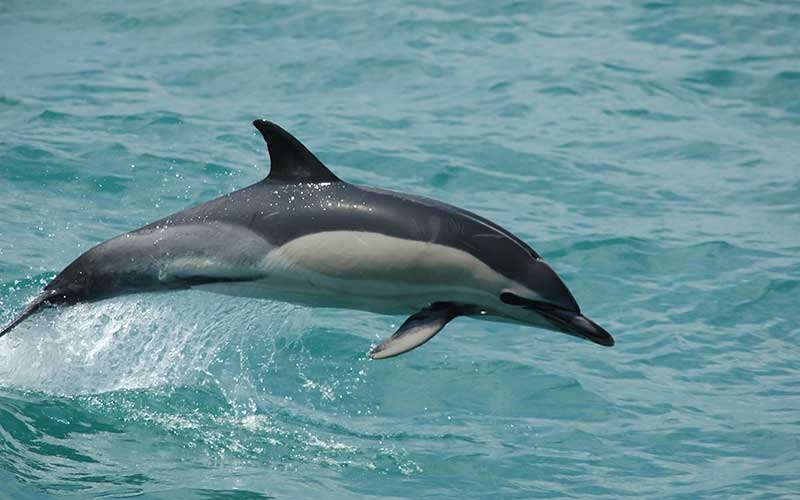Delphinus delphis
INFORMATION AND CHARACTERISTICS.
Delphinus delphis is probably one of the most common species of dolphin, and it has a broad distribution around the world. The naturalist Carlos Linnaeus was the first person to describe this short-beaked cetacean in 1758. It is probably the most abundant dolphin on the ocean.
Order: Cetacea
Family: Delphinidae
Genre: Delphinus
HOW DO THEY LOOK? PHYSICAL CHARACTERISTICS.
It is a medium-sized dolphin, similar to other common dolphin species.
Weight and size.
The sexual dimorphism is slight since males are larger and heavier than females. The average length is 1.52-1.82 meters, and the weight is 100-136 kilograms.
Morphology.
Its fusiform body has a long snout (even though is shorter than that of the Delphinus capensis) and a rounded melon. The Short-beaked common dolphin has a dorsal fin almost triangular, with a curved inclination. The pectoral flippers and the flukes of their caudal fin are small.
Skin Coloration.
Its coloring pattern features a dark dorsal area and a white ventral region. From the end of the beak starts a layer of dark color that extends toward the dorsal fin and the sides, forming a “V.” From the lower jaw to the flippers, there is a narrow black stripe, and a dark patch is around the eyes. Along the sides, there is a thick band of light color that does not become white.
Distinctive characteristics.
The shape of the coloring pattern is its most distinctive sign. To distinguish it from Delphinus capensis, which is very similar, the size of the beak is the main feature that makes them different.
> Short-beaked common dolphin characteristics.
> Short-beaked common dolphin – Delphinus delphis.
WHERE DO THEY LIVE? DISTRIBUTION AND HABITAT.
This dolphin inhabits all tropical, subtropical and warm seas of the world, especially in the Pacific and Atlantic oceans. In the south of Australia. In the western Atlantic it extends from Newfoundland to Florida in the United States; From Norway to West Africa in the eastern Atlantic, from Canada to Chile in the eastern Pacific Ocean; In the central region of this ocean and around New Caledonia, New Zealand and Tasmania. It has a presence in a few closed seas: the Sea of Japan, the Sea of Ojotsk (Asia) and the Black Sea.
It inhabits coastal areas or the high sea as long as the water temperature is 10 to 28° Celsius. It dwells along the continental slope, in waters with depths ranging from 200 to 2,000 meters and has a preference for the marine areas where the upwelling occurs and for the seamounts and escarpments.
WHAT DO THEY EAT? DIET AND EATING HABITS.
Small fish such as herring, sardines, hake, and anchovy are an important part of their diet, also cephalopods which include octopus and squid. They consume crustaceans to a lesser extent. In total, an adult dolphin consumes more than 8 kilograms of food per day.
It feeds mostly at night, and it has cooperative hunting strategies. When a group of dolphins is looking for food, each member submerges for up to 8 minutes to detect prey. If they are successful and find a school of fish or any other prey, they can perform two hunting strategies:
1.- Individually, these dolphins approach the center of the school of fish and chase them. Before the prey escapes, they catch it.
2.- Dolphins dive towards a school of fish chasing them to guide them towards the surface of the water. They prefer to feed at night because they wait for the prey that migrates to the surface every night.
The whole hunting process takes about 1 hour, and they can submerge up to 200 meters deep during the process.
HOW DO THEY BEHAVE? BEHAVIOR
It is very rare to find a Short-beaked common dolphin alone. These dolphins are very social which can be seen in all their daily activities like eating, traveling and even breathing. The pods are very numerous and are composed of 10 to 500 individuals but, as in other species, they usually associate with other pods forming large temporal groups of thousands of dolphins. Its association with other species of cetaceans like the pilot whales (Genus Globicephala) is also common.
This species is a perfect example of a playful dolphin. It jumps, hits the water with its flippers, and spin in the air for several hours. Without a doubt, their favorite game is to ride the bow waves of boats. Its swimming speed reaches up to 60 kilometers per hour.

Short-beaked common dolphin – Delphinus delphis.
It shows great empathy for its peers. When a member of the pod is sick or injured, another dolphin helps him to float and breathe, a fact that demonstrates their capacity for bonding. This dolphin can remember its mates even though it has been a long time since they separated and experiences joy and excitement. In the same way, if one dies or separates, it shows sadness.
Individuals in some regions migrate seasonally in a process induced by the temperature increase of the surface water.
HOW DO THEY REPRODUCE? MATING AND REPRODUCTION.
An unusual fact about the reproduction of this dolphin is that, although it is usual to have only one offspring, there are some cases of births with 2 and up to 3 dolphins, when in other species this happens much less frequently.
Males reach sexual maturity between 12 and 15 years of age, but females are mature when they reach 85 percent of their final size and if they have ovulated at least once in their lifetime. But the sexual maturity and the interval of births vary considerably among populations since in some parts these dolphins reach maturity at 2.7 years; In the eastern Pacific Ocean females give birth every three years, but in the Black Sea they can do it every year.
Their sexual habits are not only for reproduction. They can participate in activities that provide pleasure for themselves or their peers. During spring and autumn, males begin to courtship females with actions involving physical contact and approach, then both mate. Females have a gestation period of 10-12 months.
From the moment of its birth, the offspring is of vital importance for the mother and the pod; It swims next to its mother and separates just a few feet from it as it grows. Weaning occurs when offspring are between 5 and 19 months of age.
WHAT IS THEIR CONSERVATION STATUS? THREATS AND CONSERVATION.
Conservation Status: “Least Concern.”
By-catch with longlines, gillnets, and trawls constitutes the greatest threat to the survival of this species. In Asia and areas of the Mediterranean Sea, is hunted for human consumption to prepare some little-known dishes, but also for its oil. Additionally, the chemical contamination and the human disturbance of their habitat are also important factors, although fortunately the species still has a conservation status of “Least Concern” on the Red List of the International Union for Conservation of Nature.
The species has the safeguard of the Marine Mammal Protection Act of 1972. In the United Kingdom, killing cetaceans is banned by the law. Seven European countries signed the Agreement on the Conservation of Small Cetaceans in the Baltic, North East Atlantic, Irish and North Seas (ASCOBANS). Also, there are plans to create protected areas for this dolphin and to control the pollution of its habitat.
References
William F. Perrin, Bernd Würsig, J.G.M. ‘Hans’ Thewissen. Encyclopedia of Marine Mammals. Academic Press, 2009. Page 255.
Mammals in the Seas: Small cetaceans, seals, sirenians and otters. Food & Agriculture Org., 1978.
http://www.cms.int/reports/small_cetaceans/data/d_delphis/d_delphis.htm
http://www.iucnredlist.org/details/6336/0

